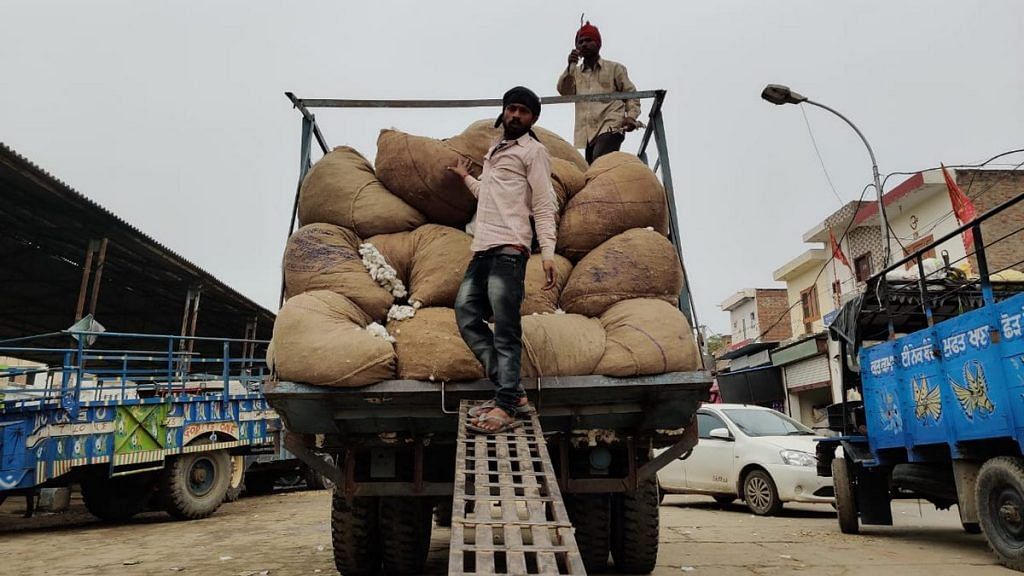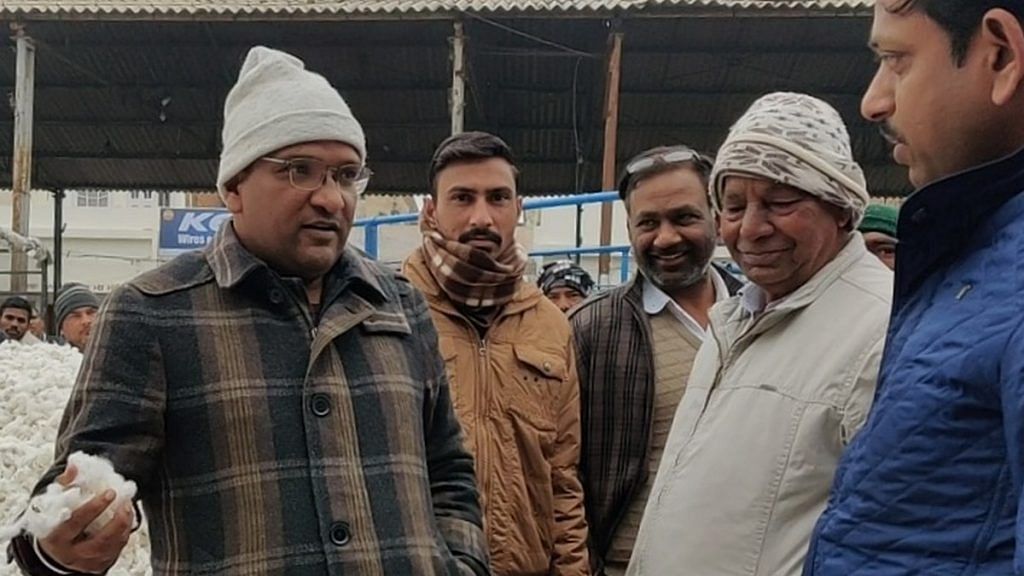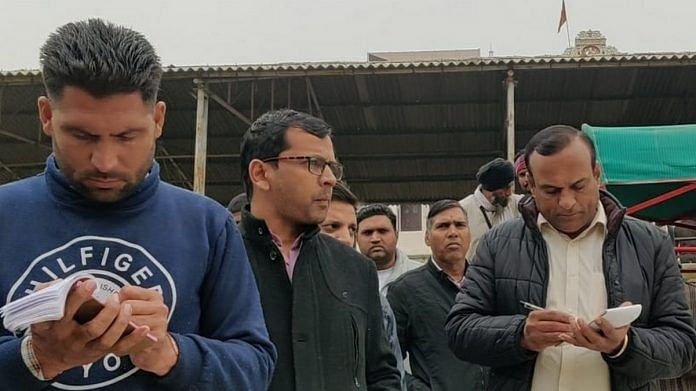Bathinda: One of the reasons the Narendra Modi government has cited for introducing the three new agriculture laws is to free farmers from the ‘clutches’ of arhatiyas or commission agents.
Arhatiyas facilitate trade in Agricultural Produce Marketing Committee (APMC) mandis, and levy fees for the service, which comes out of the pockets of farmers and buyers. And since APMCs have a monopoly in the farm produce market, the farmers don’t get the benefit of competition, which would get them a better price. As a result, farmers end up producing paddy and wheat — the two commodities for which the government offers a minimum support price (MSP). This has led to a paddy-wheat monoculture that has brought agrarian crises to once-prosperous Punjab.
The total market charges for agricultural trade in Punjab are 9.5 per cent of the value of the produce — the charges consist of 3 per cent infrastructure cess on wheat-paddy, 2 per cent market fee, 2 per cent rural development fund, and 2.5 per cent arhatiya commission. The new farm laws remove all these extra charges from agricultural trade to attract more buyers for the farmers’ produce, creating competition and attracting better prices.
But the farmers aren’t convinced — their months-long protest has featured the demand to repeal the laws and keep the mandi–arhatiya system in place. The arhatiyas are supporting the farmers by halting agricultural trade through strikes in Punjab’s mandis.
Also read: Wedding planning, feeding buffaloes, farm work — neighbours step in as Punjab farmers protest
Who are arhatiyas?
Arhatiyas are commission agents in mandis who facilitate the transaction of crops between farmers and actual buyers like processors, exporters and government agencies like the Food Corporation of India (FCI). There are 1,858 mandis in Punjab and 400 in Haryana, and more than 23,600 and 22,000 arhatiyas are registered in the states respectively.
Farmers bring their produce to an arhatiya’s shop inside the mandi, where it is cleaned, weighed and filled into sacks, and then sold through an open auction. For this, they charge farmers and buyers a fee.
Arhatiyas were the traditional moneylenders in what are now Punjab and Haryana, and came into agriculture when regulated markets came into the picture. The Green Revolution’s capital-intensive nature increased farmers’ financial needs through the greater use of machines, chemicals and other inputs. Arhatiyas provided easy credit, on a high interest rate, for purchasing seeds, fertilisers etc. during the sowing season, as also for domestic needs like weddings or vehicle purchases etc.
Arhatiyas still provide non-institutional credit to farmers, since institutional sources such as banks haven’t been able to meet their multiple credit requirements.
How arhatiyas ‘grip’ farmers
Under the APMC system, arhatiyas sell the produce, receive a payment plus a commission, and then forward farmers the earnings after deducting outstanding loans they’ve provided them.
They account for 66.74 per cent of loans provided in villages without a bank in Punjab, and 54.45 per cent in villages and areas with one or more banks.
The average rate of interest charged by arhatiyas is in the range of 15-24 per cent per annum, against 8 per cent charged by institutional sources of finance.
“But bank loans take time, collateral and paperwork,” Darshan Singh, a 10-acre farmer in Bhai Bakhtaur village in Bathinda, told ThePrint. “Arhatiyas give us loans at any time, even at night, for immediate fertiliser or pesticide spray.”
But these frequent, high-interest loans end up thrusting Punjab into a cycle of exploitation — they can never pay off their loans due to increasing agricultural and livelihood expenses along with falling incomes and reducing landholding.
Sucha Singh Gill, agricultural economist and senior professor at the Centre for Research in Rural and Industrial Development, said, over the decades, the characteristic of the arhatiya profession has also changed due to caste. He explained that earlier, arhatiyas were mostly baniyas, but now, large landowning Jat farmers who reaped the benefits of the Green Revolution, have started investing their profits into the arhatiya profession. This, he said, has made for stricter repayment policies, and mortgaging the land of indebted farmers.
“Earlier, arhatiyas were not landowners, so they were polite in their dealings with farmers. But with jats becoming arhatiyas, they take over a farmer’s land if he defaults,” Gill said.
This, in turn, has reduced landholding, and thus, farmers’ income, pushing them into debt and distress, he added.
However, Vijay Kalra, president of the Federation of Arhatiya Associations of Punjab in Makhu village, Ferozepur district, defended the profession by saying they are necessary service providers, not mere ‘middlemen’.

“Arhatiyas are not middlemen, as labelled by the government. We are a crucial service provider necessary for both farmers and buyers. Everyone sees the commission we take, but not our expenses — we engage at least 7-8 workers for processing crops, along with an accountant and various other staff for clerical purposes,” Kalra said.
“There are many miscellaneous costs that an arhatiya has to bear, such as electricity, electronic weighing scales and tarpaulin covers for unlifted grain. We even have to occasionally please officials to accept grain that may have moisture beyond the prescribed limits, so that our farmer doesn’t suffer losses,” he said, adding that in the end, an arhatiya only saves about half a per cent of the total amount, not the whole 2.5 per cent fee that is charged.
Also read: ED and I-T heat on farmer leaders, arhatiyas and ‘singers & actors supporting the agitation’
Why can’t farmers get out of their clutches?
The simple answer to this question is lack of access to formal credit. When facing a cash crunch, farmers take loans from arhatiyas, sometimes even for daily needs, and get it in the form of a ‘parchi’ or slip. This way, an arhatiya can force farmers to buy articles from their shops or those they have tie-ups with, rather than providing cash outright.
In a 2011 academic paper, Punjab Agricultural University professor Sukhpal Singh and Punjabi University (Patiala) professor Tejinder Dhaliwal wrote that about 24 per cent of them have a grocery business, while another 31 per cent belong to various types of professions. A majority of the commission agents are farmers, grocers, rice shellers, and owners of pesticide/fertiliser shops.
The parchi is deducted at crop procurement, making the farmer, in a sense, a bonded seller and a bonded buyer.
Praveen, an arhatiya in Maur mandi, Bathinda, explained just why the farmers can’t afford to go the formal credit route, by talking about “subsidised interest”.
The central government provides farmers the facility to avail concessional crop loans up to Rs 3 lakh at 7 per cent interest. It also provides additional lowered interest (subvention) of 3 per cent for prompt repayment within a period of one year. This helps farmers to avail crop loans at a rate of interest of only 4 per cent per annum.
“The loan from the bank is subsidised to a limited amount — up to Rs 3 lakh at Rs 70,000 per acre. However, we provide loans to them round the clock, throughout the year,” Praveen said.
“We take our cut when the farmer crop is sold, including labour and another processing costs at the mandi, apart from prior loans which the farmer has taken for crop spray, diesel, festival/education/ration and other daily needs.”
The Centre and the state of Punjab, in the past, have made efforts to free farmers from arhatiyas, through attempts such as trying to make procurement agencies pay the farmers directly, which would bring in transparency. This would let the farmer repay according to his or her capacity. But little has been achieved so far, because the capital-laden arhatiyas are a powerful lobby, and have opposed such moves, because they fear this will take the farmers, and thus their profits, away.

Sukhpal Singh and Tejinder Dhaliwal’s critique of the commission agent system in Punjab agriculture found that 44 per cent of farmers have been dealing with the same arhatiya for more than one generation, because of the unending cycle of debt, and because they have to take informal clearance from their old commission agents by repaying their dues before joining a new commission agent.
Vijay Kumar, another arhatiya in Maur mandi, Bathinda, told ThePrint: “My farmer cannot sell his crop to other agents unless I provide him with a clearance certificate. This is because farmers take frequent loans from us for livelihood expenses.”
Also read: Research shows intermediaries’ role is misunderstood. Local market realities more at play
Why are farmers opposing the change?
Farmers in Punjab fear that the creation of private mandis and the subsequent removal of assured procurement will affect their relationship with arhatiya. They fear this would delay credit for the next crop, livelihood expenses and profitability.
Mahinder Singh, a farmer in Bathinda, said: “Arhatiyas give us the money in advance because they know that the government will procure our paddy and wheat at MSP. This would ensure them a commission from both, and keep their business running. But the corporate sector will just pay us for crops but not for personal needs. What if we need the money urgently?”
Kulwinder Singh, a farmer from Bathinda’s Maiser Khana village attached to arhatiya Praveen mentioned above, added: “We are very happy with our arhatiya because he always provides us with the payment in cash instantly, so we don’t have to run to banks with cheques and all. All I have to do is to dump my crop here and do nothing more, rest is taken care of by him to the point of sale, after which I receive my payment.”
Bhoora Singh, another farmer from Bathinda’s Bhai Bakhtaur village who cultivates cotton and rice on five acres of land, said: “Arhatiyas loan us money even for resolving family issues or buying cattle, land or vehicles. Even if the output of our crops is not very promising, they still loan us money for next season for pesticides. They also arrange pest spray machines even if we face a shortage in supply.”
Arhatiyas fear that with the abolishment of mandis and the assured wheat-paddy procurement, they will be thrown out of work due to direct trade between private firms and farmers.
However, experts like Prof. Gill don’t agree. Gill said: “Arhatiyas have extensive capital and networking among farmers. Even if the private companies come to Punjab, they will hire arhatiyas to do their groundwork.”
Also read: Bella Ciao to farm laws wapas jao — Anti-Fascist anthem goes Punjabi to mark farmers’ stir
This report has been updated to reflect the correct percentage of the total market charges for agricultural trade




Who right this article please do a farming himself
Then write about these things
Don’t do modi chamchagiri
The agitators seem to be the contract farmers managing the 1000s of acers of land grabbed against the loans given to poor farmers.
With their political clout they make sure the crop cultivated on free electricity, subsidized fertilizers and contract labour brought from UP. Bihar and some other parts is bought by the government at MSP.
No record of land taken on lease all cash transactions. A tight grip on the poor farmer who is under debt which seems to be the support base. The bunch that is challenging the state rules with violence only.
In a nut shell, it is a feudal set up and the stakeholders have definite vested interest in perpetuating the old system. Govt need not have brought these laws, even though it did with the best of intentions without understanding the inner nuances of inter se relationship and mutual dependability of members of the group. To perpetuate the system, Govt will have to procure all the produce ( whether needed or not) and pay at MSP ( whether it is justified or not ) and should not look at the quality of the grain ( it is not the concern of the Arahatyas). In other words, it is the tax payers of the country who perpetuates this feudal system. Tax payer does not get anything in return – and the system plainly tells the tax payer – you pay now and go to hell.
From the comments it’s very clear that the money lenders are creating havoc in the farming community. Ones needs to understand how this vaccum is filled in other states.
This is a vicious cycle that benefits a small group against the vast majority of rest of the country, who have to bear all these costs, either directly or indirectly, through higher fiscal deficit, hence inflation.
Punjab farm protesters are so brainwashed that they just refuse to reason out the benefits of reforms. They have been put on oath of Sikhi Da Vasta that has become the reason behind their Delli Chalo n Dharna Lao. Unfortunately their is no tall leader to guide them. Sab Chaudhary Ban Gaye te kaun kissey de Suney.
Brothers let the SC handle it now because committee members will find the best solution for entire country and its farming community…
The BJP MLA from Ambala is himself an arhatiya.
It is wrong to blame monopoly of APMCs or the wheat paddy cycle for the agrarian crisis. Any buyer can purchase any crop in APMC and the rate of charges in different states vary from 6-8%(total). Now, if a private player, especially a trader, wants to procure goods falling under Essential Commodities Act, he is not able to hoard beyond a limit, secondly, in his hunger for higher margin, he wants to escape paying the Mandi charges of all huee. This player will not pass on the benefit, of this saving, in the long run to the farmer, it will be only long enough to kill the APMC. Secondly, in 1990-2000 decade Malwa belt known for its bumper cotton production was struck by American bookworm attacks. Imagine for 10 years, neither any pesticide company, nor the Punjab Agricultural University, nor any other Research Institute, could find a solution to this. The net result was that a major chunk of it shifted to paddy. For the past 20 years, successive State and Central govt of all hues bahut their eyes to the stri reality of over production of rice and wheat, not just in Punjab or Harayana but also at National level and chose not to invest, political, financial or executive capital in solving this problem. It was the baby elephant which was being fed by both of them for short term political gains, all the time knowing that the day when it will be too big to be housed in the room, not just the door, was not very far. Now, the stage has reached that the elephant threatens to rip apart the room so the best solution as per them is to outsource the work of saving the room to a third party, knowing to well that the letters priority will be doing so in the least costly method which will be to kill the elephant ans thus save the room. The safety, security and well being of the elephant is none of anybody’s concern.
No one gives just Rs. 500 to anyone without security but arthiya gives Rs. 5 lac in five minutes without any security with only hope for good crop of farmer.. people do not know anything about farmer needs . First make a survey in villages to know what farmer needs. Think, why farmers wants arthiya.. why they do not object this system? This system only built for farmers and without this farmer cant survive.. no body will help them.. Can anybody here give Rs. 1 lac to a poor farmer for his daughter marriage or for his son who injured in road accident? Nobody can.. even banks do not give money to defaulters.. It is easy to talk here.. Every arhtiya borrow money from banks via cash credit limit at interest rate of 12% and distribute this money to farmers at interest ate of 15% to 18%. Bad debt ratio is so high so no profit in interest. They survive only on 2.5% commission and by this every arhtiya taking care of hundreds of farmer families. If this happen, You will destroy farmers..
Right broo
Who write this nothing know about farming
Scoundrels
So you want farmers depend on Arthiyas for their whole life and not to become free and stable with their finances like others in various countries and in other states of India.
You see 2.5% commission as small amount considering the volume they are dealing ? And again charging insane higher interests ?
Nice justification !!!!